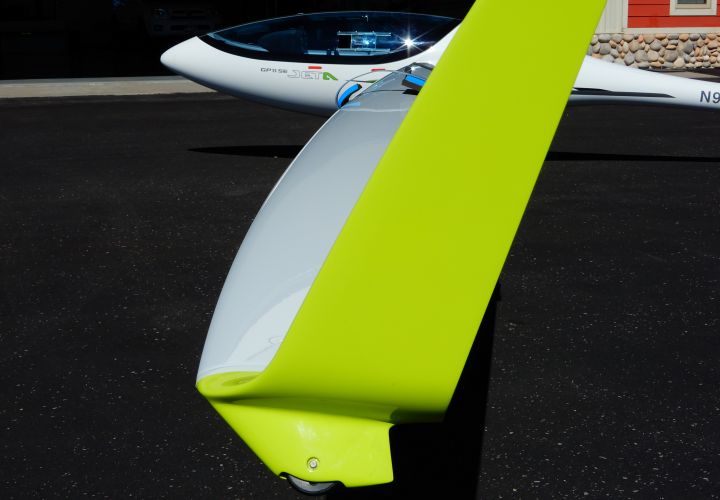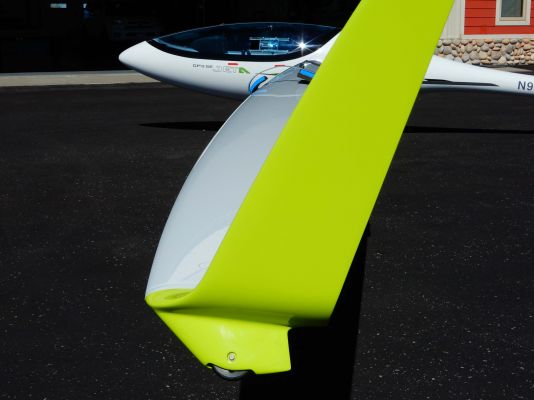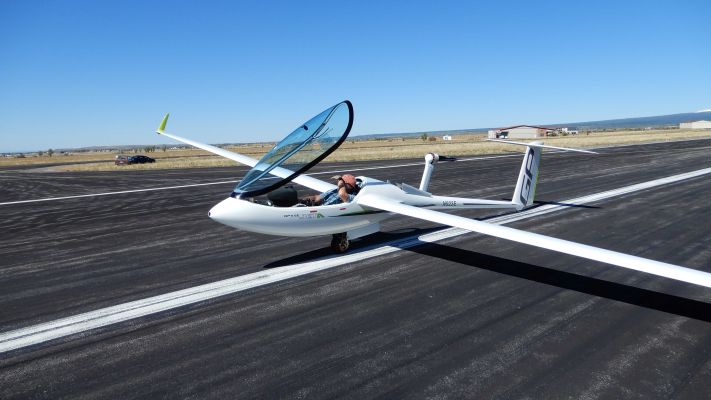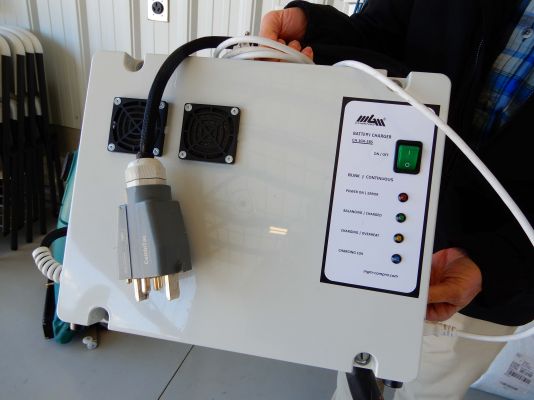"The aircraft flies well and seems very stable. Take-off is very easy and straightforward. I have used a wingtip runner for all of my departures thus far but next week I’ll be in Driggs alone and will advise on unassisted take-off. Driggs has a field elevation of 6300 feet and it takes less than 1000 feet to lift off. I’ve been using 100% power to about 200-300 feet AGL, then reducing to 80% until 1000 – 1500 ft AGL. This is the altitude I’ve started looking for thermals and have been trying different power settings to conserve battery and maintain altitude until I locate lift.
I still need a bit of time to get the feel for steep turns in thermals and best airspeeds to fly. Leading with a bit of rudder for good coordination into the turns seems to help. I’ve never flown a glider with flaps and #001 has (-1 - +5), so many choices. I need a bit more time to figure out how best to use the flaps. It is a better glider than I am a glider pilot.
I need a few more landings to figure out the proper approach speed and technique to land smooth with minimal roll. It will float forever if you allow it, very slick airframe.
The narrow cockpit is tight, once in you are fine. Trim control is close enough to the pilots left arm to make it unnatural, I’m going to recline the seat more and see if that helps. The good news is the aircraft doesn’t seem to require a great deal of trim changes. When entering a thermal, slowing down and adding flaps negates the need for big trim changes. Given a choice, I’d probably get the wider cockpit unless I flew contests, not that it is uncomfortable, but the extra width would allow more room for a water bladder and getting to your phone. The wider cockpit will also allow more room for the Oxygen Bottle. I ended up having to buy another regulator that was shorter then changing the outlet to a 90 degree fitting to allow the bottle to fit. It works but is very tight.
The Avionics are GREAT… Once I learn how to use them…. I’ve been using the LXNAV simulator and other programs to create checklists, download Tasks and Waypoints and similar features, but have a great deal to learn to utilize the avionics. I would love to find someone that uses the LXNAV gear and spend a day with them getting mine optimized".
Stephen Wade - owner of GP 15 SE JETA S/N 001
"The first USA Jeta (GP Gliders) lives at the Driggs-Reed Memorial Airport. Owner Steve Wade accepted my request to visit him and to “touch” this beautiful new glider. Steve is a gracious and kind person who welcomed me—with my numerous questions.
Delays caused by Covid, vendors, EASA rule changes, hiring and training new employees, etc., has caused design, testing and production to take longer than any of us like. As an aside, German glider manufacturers are telling their prospects to order now because it will be years before they can take delivery. The same is likely true with other companies. If in a hurry, the best way to get a new glider, quicker, is to hope that someone changes their mind and sells their production position. This is how Steve got his without having to wait.
When I walked into the hangar, the Jeta commanded my attention with its slender lines. The new style winglets and high aspect ratio wing pulled me in closer. The blue-tinted canopy has great optics. The instrument panel is small, but not a problem since 57mm instruments are here to the rescue. Water ballast is loaded from ports on top of the wings—easy.
Electric motor extension takes only 4 seconds. Since the Peszke family (GP Gliders) has been in the composite propeller business for many years, the vibration-free motor-prop combination was no surprise. Steve does not need to wear a headset or earplugs during takeoff and climb. Battery charging is done with a briefcase size charger. Full charging takes about six hours.
Steve demonstrated a no-wingrunner takeoff; nothing special to report other than normal. The climb rate was impressive. At 300’, he reduced motor power to 80%; all of this happened before passing over the runway’s departure end. Not only that, but this was an intersection takeoff on RW 22. Before this takeoff, we had reviewed previous flight logs to estimate an average climb rate: 800 fpm AVERAGE from 6,000’ msl Driggs. Landing takes about 800’ of runway.
Back to the flight, takeoff begins LS-6 style: negative flaps to about 10 knots, then zero flaps. Steve reports that in-flight flap changes need little to no trim adjustments.
We talked about the problem associated with his lengthy shipping time. The glider waited for over a month at Bremerhaven, Germany before being placed on the ship bound for Galveston, Texas. By the time it arrived, the avionics battery had drained to zero. This caused the motor-controller computer to lose some settings. All is well now, but MGM and GP Gliders are working to keep this from happening, again.
Steve’s best comment about the Jeta is that it is a “sweet flying glider.” To Steve Wade and USA Dealer Tom Holloran, thank you for arranging my visit. Steve invited me to fly his glider, but I can’t fly and drool at the same time".
Raul Boerner - delivery position holder
I still need a bit of time to get the feel for steep turns in thermals and best airspeeds to fly. Leading with a bit of rudder for good coordination into the turns seems to help. I’ve never flown a glider with flaps and #001 has (-1 - +5), so many choices. I need a bit more time to figure out how best to use the flaps. It is a better glider than I am a glider pilot.
I need a few more landings to figure out the proper approach speed and technique to land smooth with minimal roll. It will float forever if you allow it, very slick airframe.
The narrow cockpit is tight, once in you are fine. Trim control is close enough to the pilots left arm to make it unnatural, I’m going to recline the seat more and see if that helps. The good news is the aircraft doesn’t seem to require a great deal of trim changes. When entering a thermal, slowing down and adding flaps negates the need for big trim changes. Given a choice, I’d probably get the wider cockpit unless I flew contests, not that it is uncomfortable, but the extra width would allow more room for a water bladder and getting to your phone. The wider cockpit will also allow more room for the Oxygen Bottle. I ended up having to buy another regulator that was shorter then changing the outlet to a 90 degree fitting to allow the bottle to fit. It works but is very tight.
The Avionics are GREAT… Once I learn how to use them…. I’ve been using the LXNAV simulator and other programs to create checklists, download Tasks and Waypoints and similar features, but have a great deal to learn to utilize the avionics. I would love to find someone that uses the LXNAV gear and spend a day with them getting mine optimized".
Stephen Wade - owner of GP 15 SE JETA S/N 001
"The first USA Jeta (GP Gliders) lives at the Driggs-Reed Memorial Airport. Owner Steve Wade accepted my request to visit him and to “touch” this beautiful new glider. Steve is a gracious and kind person who welcomed me—with my numerous questions.
Delays caused by Covid, vendors, EASA rule changes, hiring and training new employees, etc., has caused design, testing and production to take longer than any of us like. As an aside, German glider manufacturers are telling their prospects to order now because it will be years before they can take delivery. The same is likely true with other companies. If in a hurry, the best way to get a new glider, quicker, is to hope that someone changes their mind and sells their production position. This is how Steve got his without having to wait.
When I walked into the hangar, the Jeta commanded my attention with its slender lines. The new style winglets and high aspect ratio wing pulled me in closer. The blue-tinted canopy has great optics. The instrument panel is small, but not a problem since 57mm instruments are here to the rescue. Water ballast is loaded from ports on top of the wings—easy.
Electric motor extension takes only 4 seconds. Since the Peszke family (GP Gliders) has been in the composite propeller business for many years, the vibration-free motor-prop combination was no surprise. Steve does not need to wear a headset or earplugs during takeoff and climb. Battery charging is done with a briefcase size charger. Full charging takes about six hours.
Steve demonstrated a no-wingrunner takeoff; nothing special to report other than normal. The climb rate was impressive. At 300’, he reduced motor power to 80%; all of this happened before passing over the runway’s departure end. Not only that, but this was an intersection takeoff on RW 22. Before this takeoff, we had reviewed previous flight logs to estimate an average climb rate: 800 fpm AVERAGE from 6,000’ msl Driggs. Landing takes about 800’ of runway.
Back to the flight, takeoff begins LS-6 style: negative flaps to about 10 knots, then zero flaps. Steve reports that in-flight flap changes need little to no trim adjustments.
We talked about the problem associated with his lengthy shipping time. The glider waited for over a month at Bremerhaven, Germany before being placed on the ship bound for Galveston, Texas. By the time it arrived, the avionics battery had drained to zero. This caused the motor-controller computer to lose some settings. All is well now, but MGM and GP Gliders are working to keep this from happening, again.
Steve’s best comment about the Jeta is that it is a “sweet flying glider.” To Steve Wade and USA Dealer Tom Holloran, thank you for arranging my visit. Steve invited me to fly his glider, but I can’t fly and drool at the same time".
Raul Boerner - delivery position holder






















